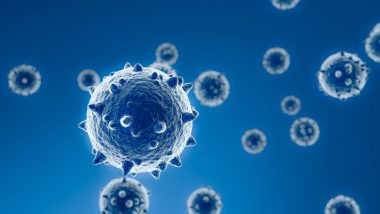Los Angeles, December 14: A smart ring that generates continuous temperature data may flag COVID-19 in its very early stages, even in cases when the coronavirus infection is not suspected, a new study says. According to the research, published in the journal Scientific Reports on Monday, the device can be a better illness indicator than a thermometer, and may lead to earlier isolation and testing, curbing the spread of diseases like COVID-19.
In the study, scientists, including those from the University of California San Francisco analysed data from 50 people previously infected with the novel coronavirus and found that data obtained from the smart ring accurately identified higher temperatures in people with symptoms of COVID-19. Fake COVID-19 Vaccines, Remedies Flooding Dark Web: Report.
While it is currently not known how effectively the smart ring can detect asymptomatic COVID-19, the scientists said for 38 of the 50 participants, fever was identified when symptoms were unreported or even unnoticed.
"Many factors impact body temperature. Single-point temperature measurement is not very meaningful," said study co-author Ashley Mason from UCSF. "People go in and out of fever, and a temperature that is clearly elevated for one person may not be a major aberration for another person. Continual temperature information can better identify fever," Mason explained.
While the number of study participants was too small to extrapolate for the whole population, the researchers said they were encouraged that the smart ring detected illness when symptoms were subtle.
To conduct the study, the scientists used Oura Ring -- a wearable sensor made by the Finnish startup Oura -- which pairs to a mobile app, and continuously measures sleep and wakefulness, heart and respiratory rates, and temperature.
The researchers provided the rings to nearly 3,400 health care workers across the US, and enrolled more than 65,000 participants worldwide in the now concluded observational study.
A continuous record of the participants' biomonitoring data was available for analysis from the weeks before their infection, through the time of enrollment until the end of the study.
According to the scientists, the ring records temperature all the time, so each measurement is contextualised by the history of that individual, making relative elevations easier to spot. Russia Detects Its COVID-19 Patient Zero; What Does 'Patient Zero' Term Mean in Outbreak?.
The researchers said the ring could also record changes related to other illness such as increased or reduced heart rate, and changes in respiration rate, but added that these changes were not as strongly correlated. Using data from the prospective study, the scientists are currently developing an algorithm to identify when a user is becoming sick.
They plan to evaluate the algorithm in a new study of 4,000 additional participants. "The hope is that people infected with COVID will be able to prepare and isolate sooner, call their doctor sooner, notify any folks they've been in contact with sooner, and not spread the virus," Mason said.













 Quickly
Quickly











